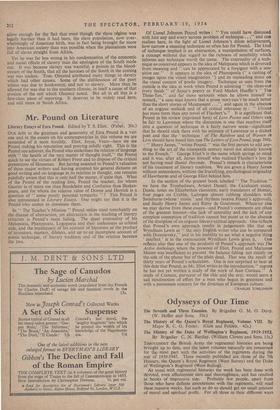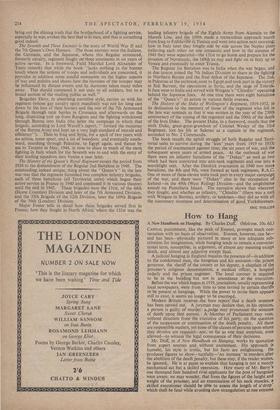Odysseys of Our Time
The Seventh and Three Enemies. By Brigadier G. M. 0. Davy. (W. Heifer and Sons. 35s.) THROUGHOUT the British Army the regimental histories are being brought up to date, and the latest volumes naturally are concerned for the most part with the activities of the regiments during the war of 1939-1945. Three recently published are those of the 7th Hussars, the Queen's Royal Regiment (West Surrey) and the Duke of Wellington's Regiment (West Riding).
As usual with regimental histories the work has been done with devoted, even affectionate care and thoroughness, and has resulted in books of impressive size. Probably few people, apart from those who have definite associations with the regiments, will read these massive works, but such as do so should get no small amount of moral and spiritual profit. For all three in their different ways bring out the shining truth that the brotherhood of a fighting service, especially in war, evokes the best that is in men, and that is something good indeed.
The Seventh and Three Enemies is the story of World War II and the 7th.Queen's Own Hussars. The three enemies were the Italians, the Germans, and the Japanese, whom this Regular armoured, formerly cavalry, regiment fought on three continents in six years of active service. In a foreword, Field Marshal Lord Alexander of Tunis remarks that while the book "lacks nothing in the• human touch where the actions of troops and individuals are concerned, it provides in addition some candid comments on the higher aspects of war and politics and shows how the fortunes of the trooper may he influenced by distant events and by decisions taken many miles away. This should commend, it not only to all soldiers, but to a broad section of the reading public as well."
Brigadier Davy, in absorbing narrative style, carries us with his regiment (whose gay cavalry spirit manifestly was not for long cast down by the loss of their horses) and the rest of the 7th Armoured Brigade through tank battles in Cyrenaica and afterwards on the long, dispiriting trek up from Rangoon and the fighting withdrawal through Burma into India (the latter the campaign in which .that brigade, according to Lord Wavell's report, " formed the mainstay of the Burma Army and kept up a very high standard of morale and efficiency"). Then to Iraq and Syria, for a spell of two years with no action, some sport, and a lot of boredom, and eventually south- ward, marching through Palestine, to Egypt again, and thence by sea to Taranto in May, 1944, in time to share in much of the stern fighting in Italy which for the Seventh was to end with the entry of their leading squadron into Venice a year later.
The History of the Queen's Royal Regiment covers the period from 1924 to the disbandment of the Regular 2nd Battalion in 1948. The _outstanding, indeed unique, thing about the "Queen's" in the late war was that the regiment furnished two complete infantry brigades, each of three battalions (all Territorial units) which began their active service in France in 1940 and continued it in various theatres until the end in 1945. These brigades were the 131st, of the 44th (Home Counties) Division and later of the 7th Armoured Division, and the 35th Brigade of the 12th Division, later the 169th Brigade of the 56th (London) Division.
Major Foster tells in detail how these brigades served first in France; how they fought in North Africa, where the 131st was the leading infantry brigade of the Eighth Army from Alamein to the Mareth Line, and the 169th made a tremendous approach march from Iraq to Enfidaville in Tunisia and went into action next morning; how in Italy later they fought side by side across the Naples plain (relieving each other on one occasion) and how in the autumn Of 1943 they were separated—the 131st to go home and prepare for the invasion of Normandy, the 169th to stay and fight on in Italy up to Venice and eventually to enter Trieste. The Regular 1st Battalion was in India when the war began, and in due course joined the 7th Indian Division to share in the fighting in Northern Burma and the final defeat of the Japanese. The 2nd, in Palestine at the outbreak,went to Egypt, and took part in the victory at Sidi Barrani, the operations in Syria, and the siege of Tobruk. It then went to India and served with Wingate's Chindits " operating behind the Japanese lines. At one time there were eight battalions of the "Queen's" in action in various fields oversea.
The History of the Duke of Wellington's Regiment, 1919-1952, in its dedication to the memory of those of the regiment who fell in the late war reminds us that it was written -in the year of the 250th anniversary of the raising of the regiment and the 100th of the death of the Iron Duke. The present Duke, in a foreword, recalls that the sixth Duke, great-great-grandson of Colonel Wesley of the 33rd Regiment, lost his life at Salerno as a captain in the regiment, seconded to No. 2 Commando. .
The book recalls the uphill struggle of both Regular and Terri- torial units to survive during the `lean'years from 1919 to 19331 the period of rearmament against time; the six years of war, and the subsequent seven years of armed peace. At the outbreak of war there were six infantry battalions of the "Dukes" as well as two which had been converted into anti-tank regiments and one into a searchlight unit. After the Dunkirk evacuation in 1940 two more battalions, the 8th and 9th, were formed as tank regiments, R.A.C. One or more of these eleven units took part in every major campaign of the war, and there were "Dukes" also in the occupation of Iceland—in the 49th (West Riding) Division—and the amphibious assault on Pantellaria Island. The narrative shows that wherever they fought, and whether as infantry, "Chindits" (there was a unit with Wingate in Burma), artillery, or tankmen—they did so with all the customary stoutness and determination of good Yorkshiremen.



































 Previous page
Previous page